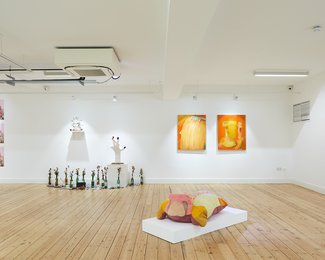
New Blood
New Blood features: Helen Clarke, Sasha Furnèe Horton, Mia Hoskins, Jaime Jover, Louise Lahive, Daniela Mendes, Katarzyna Rubach, Shannon Ryan, Lydia Stonehouse, Krystina Tyrtania and Tyler Watson.
Fri 10 Dec 2021

Could you tell us a bit more about your practice?
I mostly work with sculpture; however my pieces are also often accompanied by digital images aswell. I try to visually capture my thoughts and reflections through creating sculptures which portray the close relationship between surface and form. I am captivated by the interaction of rigid and fluid forms, and I use sculpture to convey and interpret this dichotomy through the manipulation of various materials such as wood and wire, combining them together to create new forms.
My most recent work relates to the human body. Its fluidity and movement give the pieces a personality of their own. The process involves carefully listening to the material and allowing it to take control. I perceive my pieces as individual beings in their own right and this is evident through missing parts in the surfaces, unveiling the delicate structure and bones of some of the forms. When working, I strive to stay true to the honesty and purity of my vision and try to capture the authenticity of the material. There is a flowing dialogue between the pieces; they communicate with one another just like humans, speaking a language particular to art, that of textures, colours, intentions, and intuitions. The calming colours I used tonally resonate with the softness of the forms. I particularly enjoy working with materials which are traditionally austere, such as cement, grout and cardboard and transfiguring those into something which plausibly depicts a more organic structure.
I aim to depict is a sense of vulnerability with my work, allowing the variegated aspects of the surface and form, such as the traces of cardboard- mâché infrastructure, to be exposed to different interpretations. The flaws, which are imperfections and which society teaches us to conceal, are portrayed as beautiful in their own right.
As an art student working through the pandemic please tell us about some of the challenges you faced during this time.
Apart from staying at home, myself and many other art students were faced with this hurdle of continuing our practice away from our studios. Initially I felt robbed. From being able to go into my studio space at university every day and create as much mess and chaos as I wanted, having access to various workshops and equipment, to suddenly being confined to the floor space of my bedroom.
My journey with sculpture was only just beginning when the pandemic started. I was still in the process of exploring this discipline and different materials and mediums. I was in my second year of the course and I didn’t have time to be angry at something that was out of my control. So, I turned my bedroom floor into a studio and began collecting various materials, whatever I could find. From scrap pieces of wood, to left over chicken wire, to cardboard and even foam. I started small, from sketches to maquettes, and went bigger. Alongside my sculptures I also became very interested in surfaces. I became a regular customer at B&Q, where I would buy whatever I thought I could mix with water, such as grout or cement, and mixed with things I had accessible to me at home, such as dirt or sand.
All artists were forced to adapt during the lockdown, do you think these circumstances effected your practice in any way and did you manage to find new ways of getting your work ‘out there’, such as online exhibitions?
My creativity suffered at the start and adapting wasn’t easy. But with my final year of university fast approaching I knew my perspective had to change. Regular walks and trying to stay connected with the outside world helped. I became a lot more in-tune with my surroundings and took pictures of anything that caught my eye, whether it was a form or a pattern. I would then go home and pick out the images which resonated most with me and my practice. The ones which I found most intriguing I tried to incorporate them into my sketches and Macquet’s.
As a group of artists going through the same thing, me and my group would frequently get together on zoom, with the aim of creating a ‘studio’ atmosphere. Although virtual, it was a great way in which we were able to connect and inspire one another. We often collaborated and created virtual exhibitions and workshops for eachother. For a developing artist, contact with other artist is crucial and so this was a great way to stay connected.
Exhibitions such as New Blood aim to support early career artists by exposing them to new audiences, but this can only go so far. Is there anything that galleries could, or should, be doing to help develop your career further?
As the art industry is starting to pick back up again after the pandemic, it can be scary finding your feet as a new career artist now more than ever. Aside from open calls, I think offering new artists some form of mentoring could be very beneficial. It would be great to see more opportunities in terms of assisting with exhibitions, directly meeting with other artists. Maybe even organising events in which artists can meet and exchange details.